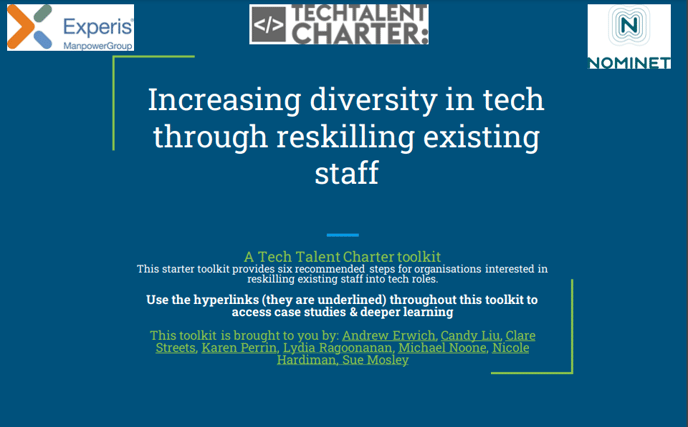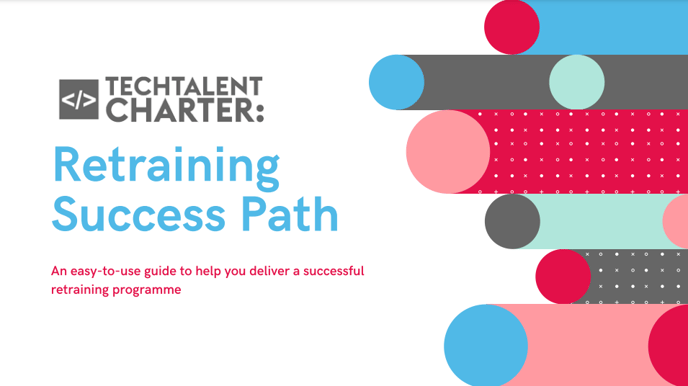Reskilling staff can create cost savings of up to £49,100 per employee compared to recruiting or making a role redundant according to a report published by the Financial Services Skills Commission (FSSC) and PwC UK.
Employer recommendations
Define why the organisation needs a reskilling programme
Consider the drivers of why the organisation needs a reskilling / retraining / career switchprogramme so this can be clearly articulated to stakeholders and ensure that the scope, focus, audience and scale of training is the right fit for the organisation. Drivers might include: offering progression routes for high performers, enabling existing employees to pivot into other business areas if their role is at risk, enabling hard-to-source job roles to filled, enabling the business to expand into new areas of work. For support, see our Tech Talent Charter resource called 'Get Started Guide: Drivers for Retraining' designed during a TTC hackathon. The full product is titled: Retraining Success Path roadmap (PDF).
Attraction and selection recommendations
-
Be bold - fish in different pools and sectors you wouldn't normally look in.
-
Remember that other (non-technical) experience still matters so consider a person's full experience in terms of their interpersonal skills, commercial knowledge, communication problem-solving skills, and professional networks. All technical roles require the ability to manage, delegate, communicate, and build relationships.
- Remove barriers for applicants such as the requirement for candidates to have a technology degree. Be more inclusive of non-traditional skills routes. Focus on key skills, core competencies and outcomes required for success in the role, rather than specific degrees or certifications or years of experience. Emphasize transferable skills, demonstrated projects, and relevant experiences.
- Keep messages, requirements and application process as simple and jargon-free as possible.
-
Demystify tech roles by describing roles in plain English and core skills (e.g. problem solving, organisational skills, stakeholder management, logic) as not everyone speaks tech language, and this can create an unnecessary barrier to applications. Be conscious of how you communicate the jobs internally and externally.
-
Clearly showcase why working in tech is an attractive option for the broadest talent pool. This article by Women in Tech is gender focused however includes some of the points worth outlining in your proposition to attract candidates into tech roles at your organisation.
- Bust myths relating to working in tech - see how techUK do this.
- Identify and seek out adjacent skills for the reskilling opportunities. Adjacent skills are a mix of technical and transferrable abilities that are related to a competency or experience an employee or candidate already has. 'A job applicant might never have had the job role you’re looking for, but they may have the necessary competencies to perform it well', Everything You Should Know About Adjacent Skills.
- Look for aptitude and potential, and strip out qualifications as a proxy for aptitude. Consider how you define and assess for ‘a passion in tech' and 'potential'. 🔦In partnership with QA, Nationwide launched a tech training programme to reskill employees from across the organisation. By focusing on potential rather than proven tech skills and experience, Nationwide was able to attract a large and diverse number of internal applicants. The intensive 12-week training programme was then designed to meet the needs of Nationwide’s future vision while factoring in the diverse background of participants from early-career with IT qualifications to career-changers with no previous IT experience at all.
🔦 Zoopla used aptitude tests specifically designed to test for some of the skills required to be a good software developer without requiring any prior knowledge of coding or software development. Read more in our Signatory Spotlight sharing how Corndel worked with Zoopla to recruit a 70% female cohort of apprentice software engineers.
-
Demonstrate and explicitly state how the organisation will support and develop candidates with complementary skills or a subset of required skills to encourage a larger and more diverse pool of candidates to apply with the confidence that they'll be able to grow at the organisation.
-
When looking at upskilling your internal workforce to fill tech roles, consider your alumni. By “elegantly” handling the exit of employees and effectively keeping in touch after they have left the organisation, you can create an open door to encourage people to return in the future.
- Where roles are at risk of being made redundant check for transferable skills of people in these roles before they leave the organisation.
-
Include lots of case studies to show candidates what's possible.
-
Provide transparent and honest communication and break down selection process.
-
Ensure selection process has clear timescales and a fast turnaround.
-
Hiring managers should play an active role by reaching out to candidates, explaining the role and career pathway for them and encouraging them to make the leap.
Programme design recommendations
- There needs to be buy in about the value of reskilling not only from the top layers of the organisation but also from the technical management level. Read more on building the business case in Reskilling: A business case for financial services organisations.
- All relevant departments must understand involvement required (e.g finance, IT, people teams) and commit to allowing learners the time and providing the necessary support required to succeed.
-
Ensure learning is flexible and recognises the diverse ways learners at different life stages like to learn, allowing for a more tailored delivery of digital education.
- Ideally reskilling is available remote and part-time with no cost to the retrainer to widen the reach to the broadest talent pools and increase uptake. Full-time, in person courses are not practical for people who can't afford to give up their day job or who have caring responsibilities.
- Existing programmes (e.g. grad programmes) can't simply be “tweaked.” Design the learning journey carefully and be clear about next steps
-
Be disciplined about the core skills that people need to master - less is more.
- Manage organisational and learner expectations throughout every stage of the training and employment journey, including before the training starts and up to a year after the learner is in the role.
- The more tailored the tech skills programme can be to the learner and to the organisation, the better the experience. Where using external providers to reskill, close collaboration between skills providers and the organisation is critical.
Supporting and retaining learners
-
Build confidence and provide lots of support such as coaching and mentoring opportunities.
-
Work with retrainers to replace unrealistic expectations with realistic ones.
- Foster a culture of knowledge/expertise sharing and collaboration. Encourage employees to share their expertise and experiences through presentations, internal blogs, or peer learning sessions. Recognize and reward employees who actively contribute to the learning and development of others.
- Encourage/create learning communities using Slack etc. These communities can be based on specific skills, interests, or industry trends.
- Celebrate learning successes: recognize and celebrate individual and team learning achievements and showcase how learning has positively impacted individuals and the company.
- Provide regular feedback and growth discussions to show that the organization is invested in their success.
- Drive collaboration and innovation by assigning employees to cross-functional projects to enable employees to apply their tech skills in a team setting and work on challenging problems. Meaningful and stimulating work increases job satisfaction and retention.
Examples of reskilling or career change programmes offered by organisations:
Research
In 2021, TTC began a deeper dive into the topic of routes to tech, developing a multi-phase project that brought together employers, digital skills providers, and government to capture best-practice, areas of need, and suggested ways forward.
During the first phase of the project, TTC worked with the Institute of Coding (IoC) and Attest to undertake research to understand how learners from tech/digital skills providers and other alternative routes into tech were perceived by tech hiring managers. The goal of this phase of work was to understand existing levels of awareness and attitudes towards non-traditional (i.e. non-degree) digital skills programmes and providers. Read more about this research.
TTC Hackathon products
👇 Download Increasing diversity in tech through reskilling existing staff (PDF)
👇 Download Retraining Success Path roadmap (PDF)
Further information
- Report: Reskilling: A business case for financial services organisations, Financial Services Commission
- Guide: Retraining Success Path roadmap (PDF), TTC Hackathon Team
- Article: Over half of women workers would consider a digital career if they knew how to retrain, says Institute of Coding research, Institute of Coding
- Report: Turning To Tech: Why are career changers the tech industry’s big opportunity to bridge the skills gap?, CWJobs
- Article: Could the Apprenticeship Levy be the answer to the UK's diversity crisis and £63bn skills shortage?
- Research: Routes to Tech: Looking at alternative digital skills provision, TTC
- Article: Why IBM Chooses Skills Over Degrees, Gallup


